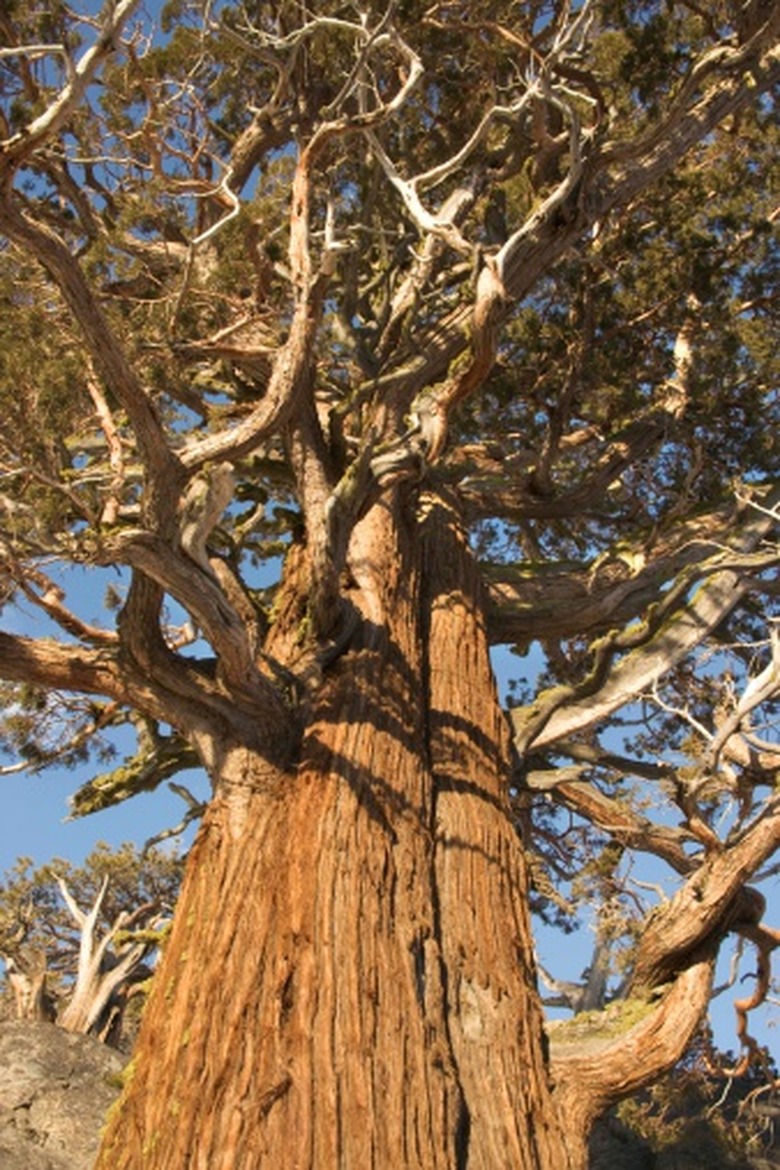How To Grow Ponderosa Pines From Seed
Things Needed
- Burlap sack
- Newspaper
- Vacuum flask
- Paper towel
- Plastic bag
- Pine bark
- Sand
- Potting soil
- 1-gallon nursery pot
- Cold frame
Ponderosa pine, or Pinus ponderosa, occurs in arid and semiarid mountainous regions across much of the western United States. Under most circumstances, ponderosa pines exceed 50 feet in height, with a single upright trunk topped by an open crown of bluish-green needles. Gardeners in hot, dry areas sometimes opt for ponderosa pine as a landscape ornamental due to its hardiness and natural resilience; however, it is relatively slow growing. Propagating ponderosa pines from seed is moderately easy, but the seeds require cool conditions after planting to prepare them for germination.
Step 1
Harvest mature cones from a healthy ponderosa pine tree in summer. Look for cones that are uniformly brown in appearance with no green around the scales or stem. Collect the cones in a burlap sack and tie it shut.
- Ponderosa pine, or Pinus ponderosa, occurs in arid and semiarid mountainous regions across much of the western United States.
- Gardeners in hot, dry areas sometimes opt for ponderosa pine as a landscape ornamental due to its hardiness and natural resilience; however, it is relatively slow growing.
Step 2
Place the sack of pine cones where it will receive strong, direct sunlight, such as on an unshaded deck or the roof of a shed. Leave the pine cones to cure and dry for approximately 20 days. Check the cones after 20 days to see if the scales have opened to reveal the seeds.
Step 3
Shake the seeds loose from the cones by grasping the tied end of the burlap sack and repeatedly striking the cones against the ground.
Step 4
Spread a layer of newspaper over a large work surface. Dump the contents of the burlap sack on the newspaper and separate the seeds from the broken cones and other debris. Discard any seeds with holes or cracks.
- Place the sack of pine cones where it will receive strong, direct sunlight, such as on an unshaded deck or the roof of a shed.
- Shake the seeds loose from the cones by grasping the tied end of the burlap sack and repeatedly striking the cones against the ground.
Step 5
Place the ponderosa pine seeds in a vacuum flask and fill it with warm water. Seal the top of the flask and allow the seeds to soak for 48 hours. Drain the seeds on newspaper or other absorbent material.
Step 6
Wrap the ponderosa pine seeds in paper towel and place them in a plastic bag. Store the plastic bag in the bottom drawer of a refrigerator until early spring, approximately 10 weeks before the last frost.
Step 7
Combine equal parts milled pine bark, sand and potting soil to create a well-draining and slightly acidic potting mix suitable for ponderosa pines. Fill several 1-gallon nursery pots with the bark, sand and soil mixture, creating one for each tree. Apply water to a depth of 7 inches and allow it to drain for 20 minutes.
- Place the ponderosa pine seeds in a vacuum flask and fill it with warm water.
Step 8
Sow one ponderosa pine seed in each pot of soil. Press the seed 1/8 inch deep into the soil and cover it. Spread a 1/4-inch thick layer of milled pine bark over the surface of the soil.
Step 9
Place the pots in a cold frame for the rest of winter. Apply 7 inches of water every 10 days. Open the cold frame a few days after the last frost to acclimate the seedlings to external climate conditions. Move the pots from the cold frame when air temperatures reliably reach 60 degrees Fahrenheit during the day.
- Sow one ponderosa pine seed in each pot of soil.
- Open the cold frame a few days after the last frost to acclimate the seedlings to external climate conditions.
Step 10
Plant the ponderosa pine saplings in a sunny, well-draining bed in late summer. Mulch heavily around the base of the saplings.
Tip
If a cold frame is unavailable, spread plastic wrap across the top of the pots and place them along an exposed, south-facing wall.
References
- "Conifers for Gardens: An Illustrated Encyclopedia"; Richard L. Bitner; 2007
- "The Encyclopedia of North American Trees"; Sam Benvie; 2007
